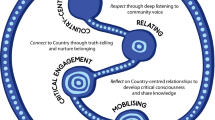Abstract
This article is based on a paper which received the “Innovation in Teaching Science Teachers” Award at the 1993 annual meeting of the Association for the Education of Teachers in Science.
Similar content being viewed by others
References
Barth, R. (1990).Improving schools from within: Teachers, parents, and principals can make a difference. San Francisco: Jossey-Bass.
Carnegie Forum on Education and the Economy. (1986).A nation prepared: Teachers for the 21st century. New York: Author.
Cobb, P. (1990). The tension between theories of learning and theories of instruction mathematics education.Educational Psychologist, 23, 87–104.
Dana, N. (1991).Four walls with a future: Changing educational practices through collaborative action research. Unpublished doctoral dissertation, Florida State University: Tallahassee, Florida.
Fullan, M. G. (1990). Staff developent, innovation, and institutional development. In B. Joyce (Ed.),Changing school culture through staff development, pp.3–25. Alexandria, VA: Association for supervision and curriculum Development.
Grundy, S. (1987).The curriculum: Product or praxis? London: Falmer Press.
Guyton, E., & McIntyre, D. J. (1990). Students teaching and school experiences. In W.R. Houston (Ed.),Handbook of research on teacher education (pp.514–534). New York: MacMillan.
Holmes Group. (1986).Tomorrow’s teachers. East Lansing, MI: Author.
Holmes Group. (1990).Tomorrow’s schools: Principles for the design of professional development schools. East Lansing, Michigan: Author.
Johnson, M. (1987).The body in the mind: The bodily basis of meaning, imagination & resons. Chicago: University of Chicago Press.
Joyce, B. R., & Showers, B. (1983).Power in staff development through research on training. Washington, DC: Association for Supervision and Curriculum Development.
Kagan, D., & Tippins, C. (1992).Negotiating a curriculum for student teaching. Paper presented at the annual meeting of the Association of Teacher Educators, Orlando, Florida.
Kincheloe, J., Steinberg, S. & Tippins, D. (1992). The stigma of genius: Einstein and beyond modern education. Durango: Hollowbrook Press, Inc.
Lanier, J. E., & Little, J. W. (1986). Research on teacher education. In M.C. Wittrock (Ed.),Handbook of research on teaching (3rd ed.) (pp. 527–569). New York: Macmillan.
Levine, M. (1992). A conceptual framework for professional practice schools. In M. Levine (Ed.),Professional practice schools: Linking teacher education and school reform. New York: Teachers College Press
Lieberman, A. (Ed.) (1986).Rethinking school improvement: Research, craft, and concept.. New York: Teachers College Press.
Little, J. W. (1989). District policy choices and teachers’ professional development opportunities.Educational Evaluation and Policy Analysis, 11(2), 165–179.
Neufeld, B. (1992). Professional practice schools in context: new mixtures of institutional authority. In M. Levine (Ed.),Professional Practice School: Linking teacher education and school reform. New York: Teachers College Press.
MidKiff, R. B., & Lawler-Prince, D. (1992). Preparing tommorw’s teachers.Action in Teacher Education, 14(3), 1–6.
Putnam, H. (1981).Reason, truth and history. Cambridge: Cambridge University Press.
Tobin, K. (1991, April).Making sense of science teaching. Paper presented at the annual meeting of the National Association for Research in Science Teaching, Lake Geneva, WI.
Tobin, K., & Jakubowski, E. (1990, April).Conceptualizing teacher roles in terms of metaphors and belief sets. Paper presented at the annual meeting of the American Educational Research Association, Boston, MA.
Tobin, K., & Espinet, M. (1989). Impediments to change: An application of peer coaching in high school science.Journal of Research in Science Teaching, 26(2), 105–120.
Tobin, K., & Espinet, M. (1990). Teacher helping teachers to improve high school mathematics teaching.School Science and Mathematics, 90(3), 232–244.
von Glasersfeld, E. (1989). Cognition, construction of knowledge, and teaching.Synthese, 80(1), 121–140.
Winitzky, N., Stoddart, T., & O’Keefe, P. (1992). Great expectations: Emergent professional development schools.Journal of Teacher Education, 43(1), 3–18.
Yeany, R. H. (1977). The effects of model viewing with systematic analysis on the science teaching styles of preservice teachers.Journal of Research in Science Teaching, 14, 209–222.
Author information
Authors and Affiliations
About this article
Cite this article
Tippins, D., Nichols, S. & Tobin, K. Reconstructing science teacher education within communities of learners. J Sci Teacher Educ 4, 65–72 (1993). https://doi.org/10.1007/BF02614551
Issue Date:
DOI: https://doi.org/10.1007/BF02614551



